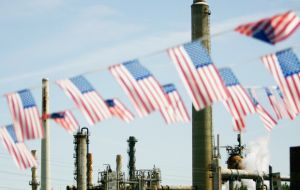MercoPress. South Atlantic News Agency
Oil price collapse hurting some more than others
 With weak demand, drillers can negotiate down rig prices. This leads to lower costs, helping drillers stay in the game.
With weak demand, drillers can negotiate down rig prices. This leads to lower costs, helping drillers stay in the game.  Unlike shale wells, offshore oil is steady and can last decades so the current period of low oil prices won’t worry corporate executives with a long-term view
Unlike shale wells, offshore oil is steady and can last decades so the current period of low oil prices won’t worry corporate executives with a long-term view  Oil production across U.S. continues to rise. In the first full week of January, it ticked up by an additional 60,000 barrels per day to 9.19 million bpd.
Oil production across U.S. continues to rise. In the first full week of January, it ticked up by an additional 60,000 barrels per day to 9.19 million bpd. U.S. oil and gas rig counts dropped to their lowest level in over four years, falling by an additional 74 units for the week ending on January 16. The lower count provides fresh evidence that low oil prices are forcing drillers to pare back operations and slash spending.
While that may soon begin to cut into actual production figures, a new Wood Mackenzie report finds a lot of nuance in the oil patch, painting a complex picture of what to expect in 2015. The report identifies several trends beyond the simple narrative that low prices will force a cutback in drilling.
First, Wood Mackenzie estimates that at $40 per barrel, many producing Wells could shut in. In fact, about 1.5 million barrels per day of production would be “cash negative” – meaning it wouldn’t even make sense to continue pumping at the most marginal wells, which tend to have extremely low-output. These “stripper wells,” which only produce 15 barrels of oil per day or less, have high costs given their level of production.
Wells producing such a tiny flow of oil may seem like a nonissue, but with hundreds of thousands of them dotting the country, they collectively account for about one-tenth of the United Sates’ production. As these wells become unprofitable, production should start declining.
Elsewhere, larger projects face a complicating set of factors that could slow drilling, but not as fast as some think. That’s because slowing activity is also pushing down the rental rates that drillers pay for rigs. With weak demand, drillers can negotiate down rig prices. This leads to lower costs, helping drillers stay in the game.
Another interesting twist occurring from lower oil prices is the fact that the economics of natural gas production have been relatively enhanced. To be sure, natural gas prices are also low, but over the last several years, the revenues generated from a barrel of oil were so much greater than the equivalent form of energy in natural gas. That pushed companies to focus on wet gas and oil.
For the equivalent amount of energy, natural gas priced at $3 per MMBtu is equal to about $17 to $20 per barrel of oil. That is still significantly lower than the $50 oil is trading for now, but the disparity is not nearly as severe as when oil was trading for $100.
With that said, the fact is that oil and gas are often produced in tandem, so a drilling cutback could hurt the gas patch as well. Nevertheless, the composition of drilling could change in favor of more gas-rich areas relative to before.
Another intriguing trend forecasted by Wood Mackenzie is the resilience of offshore oil in the Gulf of Mexico. Offshore wells are much more expensive, but have much longer production lives. They also have long lead times, making cutbacks less feasible in the short run. And unlike shale wells, production is steady and can last decades, so the current period of low oil prices won’t worry corporate executives who take a long-term view. As a result, while rigs start vanishing from shale regions, they should remain steady in the Gulf.
Still, it is not as if American shale will suddenly go into decline. Oil production across the U.S. continues to rise. In the first full week of January, oil production ticked up by an additional 60,000 barrels per day to 9.19 million barrels per day, according to the latest EIA data. Wood Mackenzie predicts that the industry will continue to consolidate and focus on the most profitable areas while finishing up projects still in the pipeline. That means the Eagle Ford in South Texas first and foremost, which remains one of the lowest cost shale basins in the country.
The thousands of oil wells across the United States are not uniform. The collapse in oil prices is hurting pretty much everyone, but some areas – core shale regions, and the Gulf of Mexico – will weather the storm better than others.
By Nick Cunningham of Oilprice.com




Top Comments
Disclaimer & comment rules-

-

-

Read all comments“....meaning it wouldn’t even make sense to continue pumping at the most marginal wells, which tend to have extremely low-output. ”
Jan 22nd, 2015 - 01:14 pm 0the dream is over isleters.
and you thought you were going to be the next dubai...LOL
Post 1
Jan 22nd, 2015 - 06:55 pm 0Our resident oil company executive has spoken LOL And tell us when do you think that Argentina will be self sufficient in energy, bearing in mind it will cost somewhere in the region of US$ 200 billion to develop. We await your comments with bated breath, LOL BOLUDO
and you thought you were going to be the next dubai..NO!
Jan 22nd, 2015 - 08:05 pm 0YOU Thought You were going to be the owners of the Falkland's and failed.
Commenting for this story is now closed.
If you have a Facebook account, become a fan and comment on our Facebook Page!